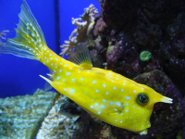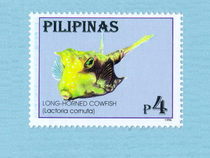Longhorn cowfish
Adults are reef fish, often solitary and territorial, live around sand or rubble bottom up to a depth of 50 m.

Original source: Own work Author Drow_male
Author: Drow_male
Permission: GNU Free Documentation License
The Longhorn cowfish lives in the reef-associated, non-migratory, brackish, marine, depth range 18 - 100 m environment.
Longhorn cowfish - A Poisonous Pet
 The Longhorn cowfish is one of the strangest-looking fish ever to swim in an aquarium. It's actually not well-suited to life in captivity, thanks to its ability to release ostracitoxin when stressed. This can have bad effects on a tank's other inhabitants. However, the Longhorn cowfish's odd appearance has made it quite popular with saltwater fish keepers. It is a type of boxfish, a group of fish that is related to the more widely recognized Pufferfish family. Most fish stick to the standard, streamlined shape, but all cowfish have a blocky, boxy shape that makes this group unique and easily recognized. The Longhorn cowfish's standard color is yellow ranging to olive with white or blue-white spots, but other morphs exist with orange or green coloration. The fish's defining feature is the set of horns that protrude from the head; they're much longer than the horns of any other cowfish.
The Longhorn cowfish is one of the strangest-looking fish ever to swim in an aquarium. It's actually not well-suited to life in captivity, thanks to its ability to release ostracitoxin when stressed. This can have bad effects on a tank's other inhabitants. However, the Longhorn cowfish's odd appearance has made it quite popular with saltwater fish keepers. It is a type of boxfish, a group of fish that is related to the more widely recognized Pufferfish family. Most fish stick to the standard, streamlined shape, but all cowfish have a blocky, boxy shape that makes this group unique and easily recognized. The Longhorn cowfish's standard color is yellow ranging to olive with white or blue-white spots, but other morphs exist with orange or green coloration. The fish's defining feature is the set of horns that protrude from the head; they're much longer than the horns of any other cowfish.
Maximum adult size - about 50 cm, or 20 inches.
Weight - Most captive specimens are young and don't weigh more than a few ounces. A large one might weigh in at a pound or two, or .5 to 1 kilogram.
Obviously, longhorn cowfish are not particularly large fish. A 6 inch fish would be considered large at a pet shop. In the wild, the longhorn cowfish is most often found on and near reefs of the Indo-Pacific region, but it also lives in still bays, harbors and estuaries with sand or mud bottoms. Young fish are often associated with Acropora corals.
The longhorn cowfish generally sticks to shallow water from 1 to 50 meters. They may be found in water up to 100 meters deep, but this is not common. Longhorn cowfish range from the Red Sea all the way to Australia and southern Japan, and they also live along Africa's southern Atlantic coast. They are not endangered, and they're common enough to be found in pet stores. Like many popular aquarium fish, longhorn cowfish are not found in the Americas.
Most boxfish are slow swimmers; they can actually be caught by hand. The longhorn cowfish is certainly not an agile hunter, so its diet consists mainly of invertebrates and benthic algae. They have even been observed blowing jets of water into the sand to uncover delectable worms. Larger fish also eat other fish when they can. Between their poisonous flesh and their scaly armor, cowfish are unattractive to many predators. The horns on the head and under the tail are thought to make the fish hard to swallow. Even so, longhorn cowfish are sometimes eaten by larger predators like albacore and bigeye tuna.
Picture of the Longhorn cowfish by Drow male, licensed under GFDL
Common names
Baka baka in Tagalog
Baka-Baka in Cebuano
Baka-Baka in Davawenyo
Baka-Baka in Tagalog
Baul-baul in Waray-waray
Buntal batu in Malay (bahasa Melayu)
Buntal kotak in Malay (bahasa Melayu)
Buntal kumbang in Malay (bahasa Melayu)
Buntal tanduk in Malay (bahasa Melayu)
Buntala atanruk in Makassarese
Buntel tanduk in Malay (bahasa Melayu)
Butiti in Davawenyo
Cá Nóc s?ng duôi dài in Vietnamese (Tiếng Việt)
Cá Nóc sứng đuôi dài in Vietnamese (Tiếng Việt)
Coffre in French (français)
Galangan in Hiligaynon
Galangan nga botete in Tagalog
Galangan nga botete in Visayan
Garibo in Mahl
Goffe in Creole, French
Goffe in Creoles and Pidgins, French
horned boxfish in English
Ikan lembu in Malay (bahasa Melayu)
Kaban-kaban in Surigaonon
Kofisk in Danish (dansk)
Kofisk in Swedish (Svenska)
Komban in Malayalam (മലയാളം)
Kongô-fugu in Japanese (日本語)
Kostera rogata in Polish (polski)
Lactoria cornuta in Bosnian (bosanski jezik)
Lactoria cornuta in Spanish (español)
Langhoring-koeivis in Afrikaans
Long horned cowfish in English
Long-horn cowfish in English
Long-horned cowfish in English
Longhorn cowfish in English
Longhorn cowfish in Unknown
Moamoa-ulutao in Samoan (gagana fa'a Samoa)
Moamoa-uluto'i in Samoan (gagana fa'a Samoa)
Momoa tara roa in Tahitian (Reo Mā`ohi)
Oblok may sungay in Kagayanen
Obuluk suñgayan in Tagalog
Obuluk suñgayan in Visayan
Pantagan in Tagalog
Pantagan in Visayan
Pega-pega in Maranao/Samal/Tao Sug
Pega-pega in Tagalog
Poisson vache à longues cornes in French (français)
Sapi sapi in Malay (bahasa Melayu)
Sarvilosserokala in Finnish (suomen kieli)
Sópw in Austronesian (Other)
Sópw in Carolinian
Ssab in Austronesian (Other)
Ssab in Carolinian
Taballong in Maranao/Samal/Tao Sug
Taballong tandukan in Chavacano
Tabarong in Agutaynen
Tabarong in Bikol
Tabarong in Kuyunon
Tabarong in Tagalog
Tabarong in Waray-waray
Tabayong in Maranao/Samal/Tao Sug
Tabayong in Tagalog
Tabayong in Visayan
Tharathombu in Malayalam (മലയാളം)
Trunkfish in English
ucurua in Fijian (vosa Vakaviti)
Vaasi in Jawe
Vayi in Kumak
കൊന്പന് in Malayalam (മലയാളം)
കൊന്വന് in Malayalam (മലയാളം)
തരതൊന്പു in Malayalam (മലയാളം)
താരതൊന്വ് in Malayalam (മലയാളം)
角箱魨 in Mandarin Chinese
角箱鲀 in Mandarin Chinese
뿔복 in Korean (한국어)


Original source: FishBase
Permission: Some rights reserved
Family : Ostraciidae
Genus : Lactoria
Species : Lactoria cornuta
Authority : Linnaeus, 1758
